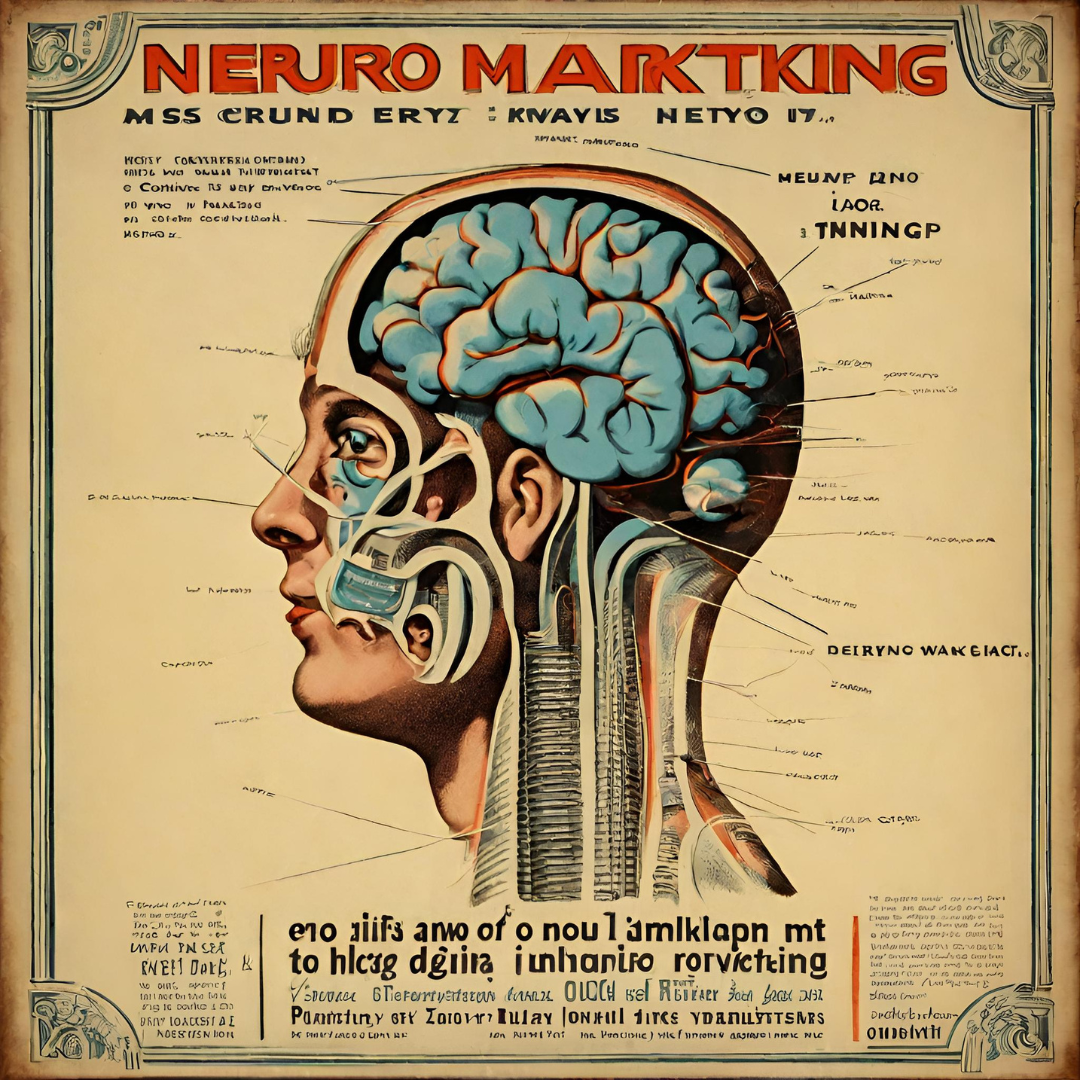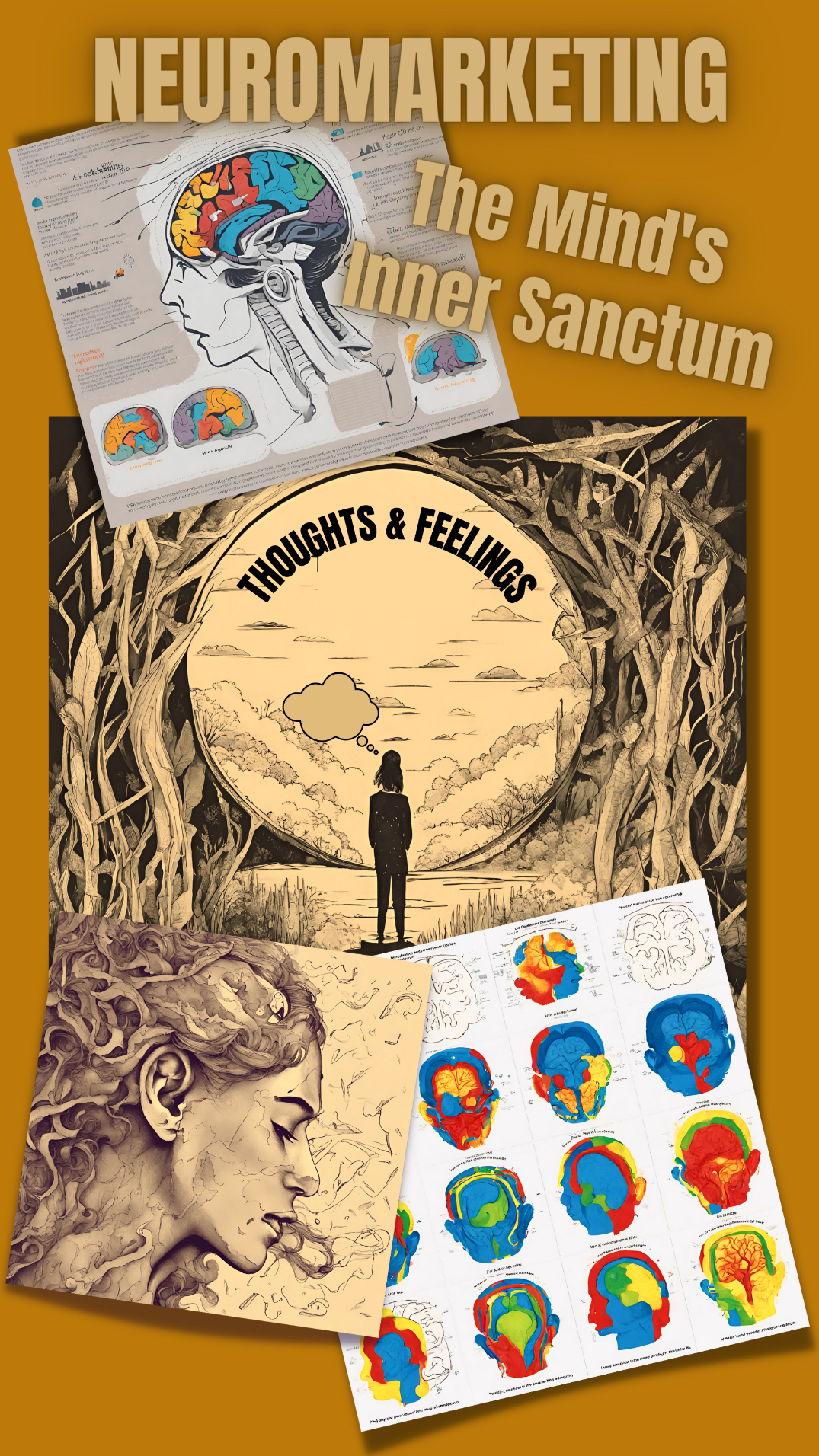
Neuromarketing - The Mind's Inner Sanctum
To the Reader:
In this white paper series, we unveil the secrets held at the intersection of three pillars of professional expertise, revealing a roadmap for those who aspire to excel in the ever-evolving field of marketing and communication. Welcome to a world where expertise is the ultimate currency, and Multimedia Marketing Group is your trusted guide on this transformative journey. The series embarks on an expedition through the realms of cognitive psychology, the 10,000-hour concept, and the unique role of Marketing Diagnostic Experts. These three pillars intersect to unveil the intricate interplay between science and intuition in advertising, marketing, and communication. This document is divided into three distinct chapters, each shedding light on a fundamental aspect of this journey.
Chapter 3
If cognitive psychology provides a window into the mind, then neuromarketing ventures into the mind’s inner sanctum. This emerging field combines cognitive psychology with neuroscience to study how the brain responds to marketing stimuli. Techniques like functional magnetic resonance imaging (fMRI) allow researchers to explore consumer reactions at a neural level.
 Neuromarketing has uncovered fascinating insights. For instance, it has shown that emotional appeals often have a more substantial impact on decision-making than rational arguments. Emotional resonance is a fundamental aspect of effective advertising. Understanding the emotional triggers that resonate with a target audience is a potent tool for marketers.
Neuromarketing has uncovered fascinating insights. For instance, it has shown that emotional appeals often have a more substantial impact on decision-making than rational arguments. Emotional resonance is a fundamental aspect of effective advertising. Understanding the emotional triggers that resonate with a target audience is a potent tool for marketers.
The emerging field that combines cognitive psychology with neuroscience to study how the brain responds to marketing stimuli is often referred to as “neuromarketing.” Neuromarketing seeks to understand the underlying neural processes and brain activity that influence consumer behavior, decision-making, and responses to marketing efforts. Here’s an expansion on this fascinating field:
- Understanding Neuromarketing:
Neuromarketing leverages advances in neuroimaging techniques, such as functional magnetic resonance imaging (fMRI), electroencephalography (EEG), and eye tracking, to gain insights into how the brain processes marketing-related stimuli. It explores how various sensory experiences, such as visual advertisements, audio jingles, or even the tactile feel of a product, affect consumer preferences, emotions, and purchase decisions.
- Key Areas of Focus:
- Emotional Responses: Neuromarketing delves into the emotional responses triggered by marketing content. It examines how different emotions (e.g., happiness, fear, excitement) impact consumer choices and how these emotional states can be induced or influenced through marketing strategies.
- Memory and Recall: Understanding how the brain encodes and retrieves information related to products, brands, and advertisements is a crucial aspect of neuromarketing. It explores the neurobiology of memory and the factors that make certain marketing messages more memorable.
- Attention and Perception: Neuromarketing investigates the neural processes underlying attention and perception, shedding light on how consumers allocate their attention to various elements within advertisements, packaging, or store displays.
- Decision-Making Processes: Researchers in this field explore the neural pathways and regions involved in decision-making, including the assessment of product attributes, comparison of options, and the influence of factors like pricing and social validation.
- Applications of Neuromarketing:
Neuromarketing has practical applications across various domains, including:
- Advertising and Creative Design: Marketers can use neuromarketing insights to create more compelling and engaging advertisements. For instance, understanding the brain’s response to specific visual elements can help design attention-grabbing visuals.
- Product Development: Neuromarketing research can guide product development by identifying the sensory cues that elicit positive or negative responses. This includes product design, packaging, and sensory experiences such as taste and touch.
- Retail Environments: In the retail industry, neuromarketing helps optimize store layouts, signage, and displays to influence consumer behavior. Retailers use this knowledge to create more pleasant and efficient shopping experiences.
- Pricing Strategies: Neuromarketing research can provide insights into how the brain processes pricing information and how price-related cues impact purchase decisions. This informs pricing strategies and discount presentations.
- Brand Evaluation: Understanding the neural processes underlying brand perception helps companies manage and enhance their brand equity. Companies can leverage these insights to reinforce positive associations and address negative ones.
- Ethical Considerations:
The field of neuromarketing raises ethical considerations, as it involves gaining insights into individuals’ subconscious responses to marketing tactics. It’s essential that neuromarketing research respects privacy and informed consent, and that its findings are used in an ethical and transparent manner.
 In summary, neuromarketing combines cognitive psychology and neuroscience to unravel the mysteries of consumer behavior, helping businesses develop more effective marketing strategies. This multidisciplinary approach offers valuable insights into the cognitive and emotional processes that underlie consumer decisions, ultimately shaping the way products and services are marketed and consumed.
In summary, neuromarketing combines cognitive psychology and neuroscience to unravel the mysteries of consumer behavior, helping businesses develop more effective marketing strategies. This multidisciplinary approach offers valuable insights into the cognitive and emotional processes that underlie consumer decisions, ultimately shaping the way products and services are marketed and consumed.
Is also interesting to note that the role of storytelling in marketing has gained prominence through neuromarketing. The brain is wired to respond to narratives. When people hear a compelling story, their brains release oxytocin, a hormone associated with trust and bonding. Marketers harness this power by crafting stories that connect with their audience on an emotional level.
User Experience and Cognitive Load and User Experience (UX)
Cognitive psychology is essential in designing user-friendly websites and applications. One of the primary considerations in this domain is cognitive load, which refers to the mental effort required to interact with a digital interface.
Cognitive psychology highlights that individuals have limited cognitive resources, and interfaces that demand excessive mental effort can lead to frustration and abandonment. Therefore, user experience (UX) designers aim to minimize cognitive load by simplifying navigation and making interfaces more intuitive.

Think about a well-designed e-commerce website. It guides the user through a seamless process, reducing the cognitive load associated with making a purchase. Product information is organized logically, and the checkout process is straightforward. The user can focus on the task at hand without getting bogged down in complex navigation or unclear instructions.
Cognitive load, in the context of human-computer interaction and user experience design, refers to the mental effort or workload imposed on a person when they interact with a digital interface, application, or website.
Understanding cognitive load is crucial for designing user-friendly and efficient digital products. Here’s an expansion on this concept:
- Types of Cognitive Load:
There are three primary types of cognitive load:
- Intrinsic Cognitive Load: This is the mental effort inherent to the task itself. Some tasks are naturally more complex and require a higher intrinsic cognitive load. For example, solving a complex math problem or learning a new language involves a high intrinsic cognitive load.
- Extraneous Cognitive Load: This refers to the mental effort caused by the design and presentation of information, which can either support or hinder task performance. Poorly designed user interfaces, confusing navigation, or unclear instructions can increase extraneous cognitive load.
- Germane Cognitive Load: This type of cognitive load is associated with the mental effort required for meaningful learning and problem-solving. It is related to deeper understanding and the integration of new information into existing knowledge.
- Cognitive Load Theory:
The concept of cognitive load is central to Cognitive Load Theory (CLT), which was developed by educational psychologist John Sweller. CLT posits that cognitive load can impact the learning process. In instructional design, it’s important to manage cognitive load to optimize learning outcomes. This theory has been extended to user experience and interface design.
- Reducing Cognitive Load in User Interface Design:
- Simplicity: Simplify the user interface by eliminating unnecessary elements. Ensure that the layout and navigation are straightforward and intuitive.
- Consistency: Maintain a consistent design throughout the interface. This includes using the same navigation patterns, button styles, and terminology.
- Chunking: Organize information into smaller, manageable chunks. For example, in web design, break content into sections with clear headings.
- Visual Hierarchy: Use visual cues like color, typography, and size to emphasize important information and guide users’ attention.
- Feedback and Error Handling: Provide clear feedback for user actions and offer helpful error messages that guide users in resolving issues.
- Progressive Disclosure: Present information progressively, revealing more as users need it. This minimizes cognitive overload and helps users focus on the task at hand.
- Effective Information Architecture: Organize content in a logical and hierarchical structure, making it easier for users to locate information.
- Applications in Web and App Design:
Cognitive load is especially relevant in web and app design. When users encounter excessive cognitive load due to confusing layouts, unclear navigation, or overwhelming information, it can lead to frustration and abandonment. Designing with cognitive load in mind can enhance the user experience, resulting in more efficient and satisfying interactions.
- Ethical Considerations:
In the digital realm, it’s important to consider the ethical implications of cognitive load. For instance, dark patterns, which are manipulative user interface design patterns intended to deceive or coerce users, can deliberately increase cognitive load to influence user decisions. Designers should adhere to ethical standards and prioritize user well-being by minimizing unnecessary cognitive load.
cognitive load plays a vital role in user experience design. By understanding the types of cognitive load and how it affects users, designers can create more user-friendly and efficient digital interfaces, ultimately improving user satisfaction and achieving better outcomes for digital products and services.
The Power of Consumer Research
Cognitive psychology techniques are frequently applied in consumer research to gain deeper insights into how individuals react to products and advertisements. Eye-tracking studies, for instance, are invaluable tools for understanding where consumers focus their attention.
Imagine a supermarket aisle filled with competing products. Eye-tracking studies reveal that consumers typically look at the top and center of product labels. Armed with this knowledge, marketers can strategically place key product information where it’s most likely to be seen, increasing the chances of purchase.
Another powerful technique is A/B testing, a method commonly used in web design and digital marketing. By comparing two versions of a webpage or an ad, cognitive psychology principles are put to the test. Which headline captures more attention? Which call-to-action button leads to more conversions? These insights are invaluable for refining marketing strategies.
The Illusion of Choice
Cognitive psychology offers a deep understanding of how choices are made. Marketers are well aware that offering too many choices can overwhelm consumers. This phenomenon, known as choice overload, suggests that when presented with too many options, people may end up making no choice at all.
Cognitive psychology helps marketers strike a balance between offering choices and simplifying decision-making. Through techniques like categorization and smart product bundling, marketers can guide consumers toward a more straightforward decision. For example, by presenting a “recommended” option or grouping similar products together, they reduce the cognitive effort required to choose.
 The Power of Storytelling in Marketing, Communication, and Beyond
The Power of Storytelling in Marketing, Communication, and Beyond
One of the most compelling applications of cognitive psychology in marketing is the use of storytelling. Cognitive psychology tells us that stories are more engaging and memorable than a list of facts. This is because stories engage multiple areas of the brain and evoke emotional responses.
Consider a heartwarming advertisement that tells the story of a child’s journey to achieve their dreams, with a product or brand playing a pivotal role. This narrative structure captivates the audience, making them feel connected to the story’s characters and emotionally invested in the brand. The principles of cognitive psychology guide marketers in creating these compelling narratives.
Storytelling is a universal and influential means of communication that transcends cultures and time. In this chapter, we will delve into the significance of storytelling, its impact on marketing and communication, and its broader relevance in various domains.
Understanding the Art of Storytelling
Storytelling is the art of conveying a message, idea, or information through a narrative. Key elements of storytelling include:
- Characters: Relatable characters serve as protagonists in the story, allowing the audience to connect emotionally.
- Plot: The plot is the sequence of events that unfolds in the narrative. It often includes a conflict or challenge that needs resolution.
- Emotion: Stories evoke emotions in the audience, whether it’s joy, empathy, excitement, or even sadness.
- Message: Every story carries a message, moral, or theme that the audience can take away.
- Imagination: Storytelling engages the audience’s imagination, encouraging them to visualize and experience the narrative.
 The Impact of Storytelling
The Impact of Storytelling
Storytelling has a profound impact in various domains:
- Marketing and Branding: Storytelling is a powerful tool for building brand identity, fostering emotional connections with consumers, and conveying the values and mission of a company.
- Communication: In both interpersonal and mass communication, stories make information memorable and relatable. They help simplify complex ideas and promote engagement.
- Inspiration: Stories inspire people, providing examples of courage, resilience, and creativity. They can motivate individuals and communities.
- Education: Storytelling is an effective educational tool that aids retention and comprehension of information. It’s often used in teaching and training.
- Cultural Preservation: Storytelling is a means of preserving cultural heritage and passing down traditions and values to future generations.
Why Storytelling Works
The power of storytelling lies in its ability to:
- Engage Emotionally: Stories tap into the audience’s emotions, making the message more impactful and memorable.
- Simplify Complex Ideas: Stories can simplify complex concepts, making them more accessible and understandable.
- Humanize Information: Stories often involve relatable characters and situations, humanizing the message and making it more accessible.
- Create Connection: Stories create a connection between the storyteller and the audience. This connection can foster trust, empathy, and loyalty.
Challenges and Mastery
Effective storytelling requires skill and practice. Challenges include maintaining audience interest, crafting compelling narratives, and avoiding common storytelling pitfalls. Mastery of storytelling involves understanding the nuances of pacing, character development, and emotional resonance.
The Universal Language
Storytelling is a universal language that transcends boundaries and speaks to the human experience. In marketing, communication, and countless other fields, the power of storytelling is a force that can inspire, educate, connect, and leave a lasting impact.
In the ever-evolving landscape of marketing and communication, storytelling remains a timeless and invaluable tool for connecting with audiences and conveying messages that resonate.
Unmasking Cognitive Dissonance
Cognitive psychology delves into the fascinating concept of cognitive dissonance, which is the discomfort we experience when holding conflicting beliefs or when our behavior doesn’t align with our attitudes. Marketers can use this concept strategically by creating situations in which consumers experience cognitive dissonance that can be resolved by making a desired purchase.
For example, a brand might emphasize the ethical and sustainable aspects of their products, creating a dissonance between a consumer’s desire to support eco-friendly practices and their current product choices. This dissonance can lead consumers to align their behavior with their values, driving them to purchase the eco-friendly product.
this psychological phenomenon that can have profound effects on decision-making, beliefs, and behavior. We’ll delve into what cognitive dissonance is, why it occurs, and how it impacts individuals in various aspects of life, including marketing and communication.
Understanding Cognitive Dissonance
Cognitive dissonance is a psychological theory developed by Leon Festinger in 1957. It refers to the discomfort or tension that arises when a person holds two conflicting beliefs, attitudes, or values, or when their actions contradict their beliefs. Key aspects of cognitive dissonance include:
- Conflict: It arises from the inconsistency between thoughts, beliefs, attitudes, or behaviors.
- Discomfort: Cognitive dissonance leads to discomfort or psychological tension, which individuals are motivated to resolve.
- Resolution: To alleviate cognitive dissonance, individuals can take actions to either change their beliefs or attitudes, change their behavior, or justify and rationalize the inconsistency.
Why Cognitive Dissonance Occurs
Cognitive dissonance occurs due to various reasons, such as:
- Inconsistent Beliefs: When individuals hold contradictory beliefs or attitudes about a particular issue or situation.
- Behavioral Inconsistency: When a person’s actions contradict their stated beliefs or values.
- Decision-Making: Cognitive dissonance often emerges when individuals make choices that result in negative consequences, leading them to justify their decisions.
- Social Influence: It can be triggered by external pressure or social influence, causing people to conform to expectations that differ from their personal beliefs.
Implications of Cognitive Dissonance
Cognitive dissonance has several implications in different aspects of life:
- Marketing and Persuasion: In marketing, understanding cognitive dissonance can help marketers craft messages that alleviate discomfort, making it easier for consumers to make a purchase decision.
- Change and Innovation: Cognitive dissonance can create resistance to change, but it can also be harnessed to promote innovation by highlighting the need for change.
- Belief Systems: It plays a role in the formation and reinforcement of belief systems, as individuals tend to justify and reinforce their existing beliefs.
- Personal Growth: Recognizing cognitive dissonance can aid personal growth and self-awareness by prompting individuals to confront and resolve inconsistencies in their beliefs and actions.
Challenges and Resolving Cognitive Dissonance
Resolving cognitive dissonance can be challenging, especially when deeply ingrained beliefs or behaviors are involved. Individuals may employ various strategies to resolve this discomfort, such as changing their beliefs, seeking social support, or reducing the importance of the inconsistency.
The Struggle for Consistency
Cognitive dissonance is a fundamental aspect of human psychology that affects decision-making, beliefs, and behaviors. It is a potent force that can both hinder and drive personal and societal change. In marketing and communication, understanding cognitive dissonance is valuable for crafting persuasive messages and addressing consumer discomfort.
In the ever-evolving landscape of marketing and communication, recognizing and unmasking cognitive dissonance is an important step toward effective persuasion and influencing behavior.
Ethical Considerations
Cognitive psychology has not only revolutionized the way marketing and communication are approached but has also brought ethical considerations to the forefront. As we understand more about how the human mind works, it becomes apparent that this knowledge can be used for both positive and negative purposes.
Cognitive biases, for example, can be exploited to manipulate consumer behavior, sometimes in ways that are not in the best interest of the consumer. Marketers must grapple with ethical questions, such as the responsibility to use cognitive psychology insights to create transparent, honest, and beneficial advertising and products.
Regulations and industry standards are evolving to address these concerns. Ethical marketing now often includes practices like providing clear and accurate information, respecting consumer privacy, and considering the potential impacts of marketing strategies on vulnerable populations.
This white paper is divided into four Chapters. Chapter four will focus on “The Cultural Lens in Marketing and Communication”
Categories
Recent Posts
- Maximize Your Reach: Essential Email Marketing Dos and Don’ts for Success July 9, 2024
- Social Media Day 2024 June 30, 2024
- Navigating the World of Social Media Advertising June 20, 2024
- The Power of Visual Content in Marketing April 8, 2024
- Hip Hopper Alert: Easter Bunny Steals the Show with Sunglasses Stunt March 31, 2024
- The Super Bowl Ads 2024 February 12, 2024
- Serving Our Client’s Social Media Platforms Branded Content February 5, 2024
- Days of Future Past January 31, 2024
- The Art of Blending Human Intuition and Data-Driven Insights January 31, 2024
- Beyond Intuition January 30, 2024
Recent Comments